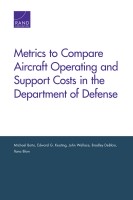| 来源类型 | Research Reports
|
| 规范类型 | 报告
|
| DOI | https://doi.org/10.7249/RR1178
|
| ISBN | 9780833091895
|
| 来源ID | RR-1178-OSD
|
| Metrics to Compare Aircraft Operating and Support Costs in the Department of Defense |
| Michael Boito; Edward G. Keating; John Wallace; Bradley DeBlois; Ilana Blum
|
| 发表日期 | 2015
|
| 出版年 | 2015
|
| 页码 | 72
|
| 语种 | 英语
|
| 结论 |
Cost per Flying Hour (CPFH) Metric Is Multidimensional and Used by DoD in Different Ways- CPFH is a metric widely used by the military services for different purposes, such as for flying-hour programs (FHP), for flying-hour reimbursable billing rates, and to compare O&S costs of different aircraft programs.
- The key difference between CPFH used for FHP and reimbursable billing and the CPFH used to compare O&S costs of different aircraft programs is that cross-system O&S comparisons intentionally include some categories that are fixed (i.e., do not vary with flying hours).
O&S Cost per Aircraft Is Alternative Affordability Metric to CPFH in Comparing O&S Costs of Different Aircraft- The CPFH metric can behave counterintuitively: When flying hours are reduced, total program costs are reduced, but cost per flight hour can increase.
- Decisionmakers could use CPFH to compare O&S costs of different aircraft when the appropriate standardization steps mentioned in the report are taken.
- Comparisons of CPFH are most appropriate when the intention is to compare costs that vary closely with flying hours, such as fuel, depot-level reparables, or perhaps engine-related costs.
- O&S costs will include elements that are largely fixed or insensitive to changes in flying hours — such as unit-level personnel, sustaining support, or modifications.
|
| 摘要 |
- The operating-and-support (O&S) costs included in the comparison should be clearly defined.
- All the direct elements of the standard O&S cost-element structure should be included when comparing O&S costs.
- Indirect costs should be excluded because, as their name implies, these costs are only indirectly affected by the aircraft, and because they are not captured consistently by the services' official O&S cost databases.
- A consistent measure of the number of flying hours per aircraft should be used when comparing costs of different aircraft. Costs of fleets should be compared using stable annual flying-hour levels needed to achieve crew proficiency and exclude flying hours for contingency operations, because variations in flying hours per aircraft affect the calculations.
- Basic data-normalization steps will be needed when comparing O&S costs of different aircraft. Costs should be compared using constant dollars to normalize for the effects of inflation at different points in time.
- Account for differences in actual costs versus estimated costs.
- Primary aircraft inventory (PAI) should be used as the measure of the number of aircraft when an annual O&S cost-per-aircraft metric is used.
|
| 主题 | Maintenance
; Repair
; and Overhaul
; Military Aircraft
; Military Budgets and Defense Spending
; United States Air Force
|
| URL | https://www.rand.org/pubs/research_reports/RR1178.html
|
| 来源智库 | RAND Corporation (United States)
|
| 引用统计 |
|
| 资源类型 | 智库出版物
|
| 条目标识符 | http://119.78.100.153/handle/2XGU8XDN/107978
|
推荐引用方式
GB/T 7714 |
Michael Boito,Edward G. Keating,John Wallace,et al. Metrics to Compare Aircraft Operating and Support Costs in the Department of Defense. 2015.
|
|
文件名:
|
x1495316221606.jpg
|
|
格式:
|
JPEG
|

|
文件名:
|
RAND_RR1178.pdf
|
|
格式:
|
Adobe PDF
|
除非特别说明,本系统中所有内容都受版权保护,并保留所有权利。